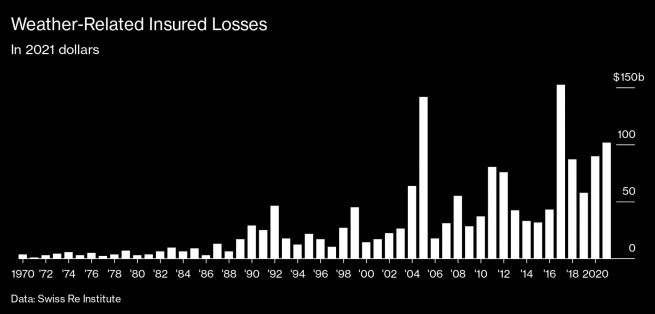The pandemic has tied a series of paralyzing knots in the global economy, but beyond the transportation delays and parts shortages lies a more enduring challenge for supply chains: climate change.
Consider that last year alone saw Hurricane Ida, a typhoon near Chinese ports, the Texas freeze, British Columbia flooding, and freak December tornadoes across the U.S., and it’s clear that global trade is struggling to cope with much more than a health crisis. As temperatures creep higher, nature is likely to be a more frequent, intense, and random economic disrupter.
An analysis of 405 extreme weather events over the past decade by Carbon Brief, a website in London devoted to climate science, shows that 70% were more likely to occur, or made more severe, because of global warming. “It’s not the next big supply chain crisis. It’s the next big supply chain crises, plural,” says Jason Jay, director of the Sustainability Initiative at the MIT Sloan School of Management. “What it ends up looking like is a set of individual crises in different places at different times. They’re hitting a different part of the supply chain, and they’re hitting it in a somewhat unpredictable way.”
Much like the pandemic, extreme weather events are acute and hard to protect against. They begin in one region but can quickly ripple through supply chains, affecting production and delivery times. In Texas, where temperatures dropped to record lows in February, the petrochemical industry was disrupted for days, affecting the supply of resins and plastics, as well as that of widely used chemicals such as citric acid and carbon dioxide, according to a report from North Carolina State University.
“The majority of refining and petrochemical capacity is in a region susceptible to not only hurricanes but also freezes like the one we had,” says Robert Handfield, a professor of supply chain management who wrote the report. “This episode was a humbling experience, and if variants in weather due to global warming continue to occur, companies need to look at alternative ways to manage their plastics and materials supply chains.”
A first step companies can take to fight extreme weather’s effects is to map their supply chains to better understand exactly where risks lie, whether that’s a supplier on the Gulf Coast subject to hurricanes or a transport hub vulnerable to flooding. “Companies don’t even know the locations of their first-tier suppliers, let alone who their suppliers are buying from,” says MIT’s Jay. “And many times these supply chains are four or five steps deep.”

Making those assessments and retooling entire supply networks doesn’t come cheap. “You don’t reduce risk for free. It costs money to have these inventory buffers, changing your strategy—all of that costs money,” Handfield says. “So I think we’re going to see higher operating costs for supply chains in general.”
Government policies designed to combat climate change may create additional costs in the short term, including legislation set to be approved by the European Parliament this year that would require businesses to carry out environmental due diligence along their entire supply chain. A report in October from HSBC Holdings Plc and Boston Consulting Group estimates global supply chains will need $100 trillion in investment to reach the goal of net-zero carbon emissions over the next three decades.
The push to curb emissions of greenhouse gases can cause unexpected disruptions. An instance of this took place in China a few months ago, when the closure of coal plants triggered an energy crunch that forced factories to shut down or reduce schedules. “I do think that there are some big challenges ahead that have just been swept under the rug for decades,” says Ethan Harris, head of global economics research at Bank of America Corp. “And the consequences of that are growing.”
No sector is more vulnerable than agriculture. Droughts or floods have claimed a large portion of Brazil’s coffee crop, battered rice production in India, and led California farmers to uproot their almond trees. Global crop yields could fall about 30% because of climate change in the coming decades, and food demand is expected to climb 50%, according to estimates from the United Nations.
Hotter than usual temperatures make construction, landscaping, and other outdoor jobs more dangerous. In countries where air conditioning isn’t widespread, even indoor work can become unbearable during an unprecedented heat wave, such as the one that forced some businesses and schools in France and Spain to close in June 2019. Research findings published recently in the Proceedings of the National Academy of Sciences showed that city dwellers around the globe experienced an almost 200% increase in extreme-heat days from 1983 to 2016. “High-heat days are actually the climate impact that sort of worries me very significantly,” Jay says.
This year may not bring “this level of profound disruption we saw in 2021 from the pandemic, but the challenges are going to continue to build over time,” says Mekala Krishnan, a partner at the McKinsey Global Institute who specializes in climate risk. “Assumptions of a stable climate are built into every aspect of our daily lives in ways we don’t appreciate.”

